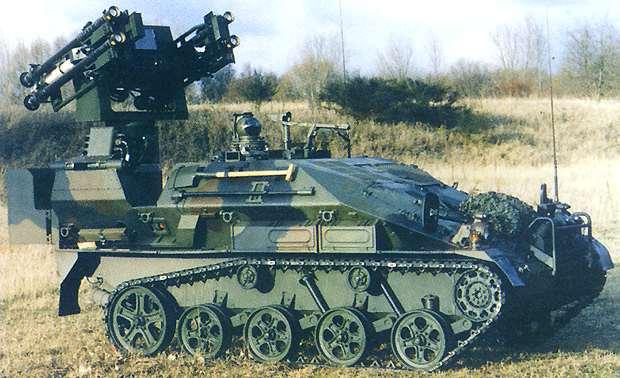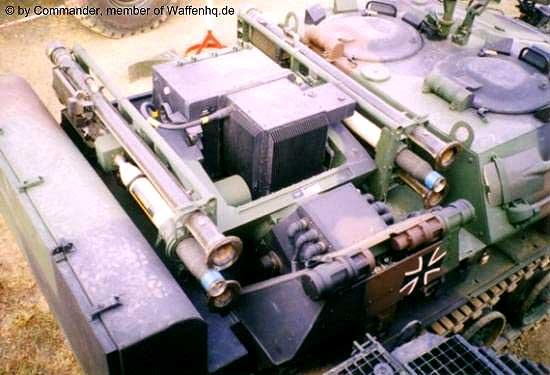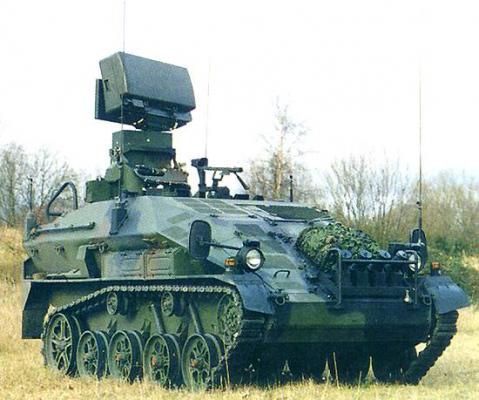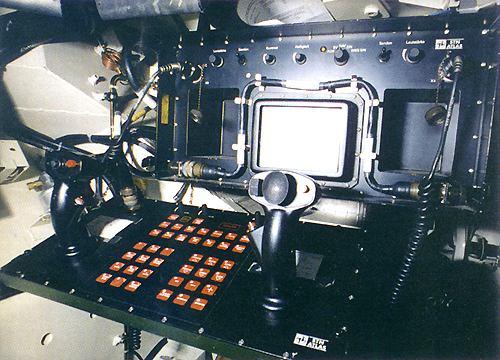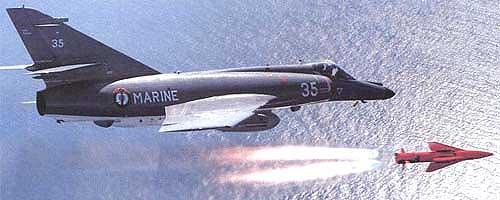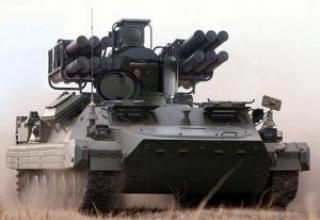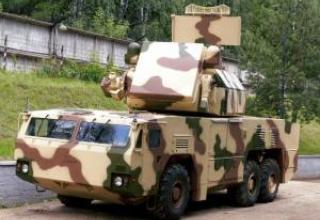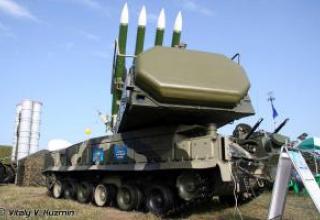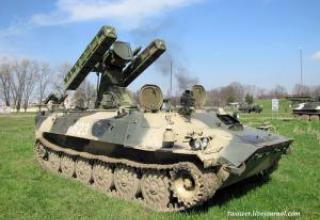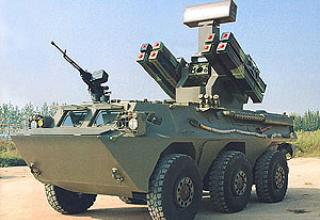Self-propelled anti-aircraft missile system "LeFlaSys" (Light Mechanized Short Range Air Defence System), developed by German companies "STN ATLAS Elektronik GmbH" and "Krauss-Maffei Wegmann" is designed to cover command posts, communication centers, air bases, units of ground forces on the march and on the battlefield from the attacks of aircraft and helicopters flying at low and extremely low altitudes.
As a means of destruction in the SAMs "LeFlaSys" are used missiles "Stinger" with infrared GSN, it is possible to use missiles such as "Needle-1", "Needle", "Mistral". The SAMs have a modular design and can be installed on various armoured vehicles and all-wheel drive vehicles.
The "LeFlaSys" SAM system placed on the "Wiesel-2" chassis developed by "Rheinmetall Landsysteme" was designated as "Ozelot". The production program, started in 2000, includes a series of 50 "Ozelot" combat vehicles, 10 platoon command posts and 7 battery command posts. The first Ozelot SAM systems entered service with the German Army in 2001.
The export version of the complex was designated ASRAD (Atlas Short Range Air Defence System).
The program of rearmament of the Greek Army includes the adoption of 54 ASRAD complexes on HMMWV chassis since 2003.
Swedish company "Saab Bofors Dynamics" together with "Atlas Electronik" have developed a version of the ASRAD-R complex, which uses missiles "Bolide", RBS-70Mk2 with laser guidance, and is equipped with a three-axis radar "Ericsson Microwave Systems HARD 3-D ". The first deliveries of the ASRAD-R complex on the "Mercedes-Benz UNIMOG 5000 4 x 4" chassis for the Finnish Armed Forces are planned for 2004.
Composition:
LeFlaSys" SAMs (ASRAD) consist of the following main elements:
- A platform rotating at an angle of position and azimuth on which four combat-ready missiles are placed in transport and launch containers, an optoelectronic device for tracking targets and missiles, a laser rangefinder and control equipment;
- control systems for angular positioning of the platform;
- a control and display unit that can be moved for remote control up to a range of 100 m from the launcher.
An additional set of manual rechargeable missiles can be kept in the fighting vehicle. The combat unit fires on the target from the cockpit of the vehicle or from a nearby hiding place using a remote control device. To enhance the effectiveness of the SAM system, it can receive information from the warning network of various detection radars and can also be used in conjunction with other SAM systems. A typical SAM system accepts target designation from a platoon command post.
The command post of the platoon is equipped with a three-axis HARD detection radar, has built-in target identification equipment "in-situ" - MSR 200 XE and optoelectronic infrared detection unit ADAD. The HARD radar, developed by Ericsson Microwave Systems, with a range of 20 km operates in the X-band and can accompany up to 20 targets simultaneously.
HARD has three modes of operation depending on the type of target: MTI (moving target indicator) mode for detection and tracking high-speed targets, helicopter detection mode and mode of operation for nonmoving targets. The radar uses a complex multiple scanning algorithm in a given search sector and provides automatic tracking of all types of targets in electronic countermeasures. One radar can provide radar information to up to eight LeFlaSys combat vehicles located at a distance of up to 20 km. The data is transmitted over a radio line.
The Ozelot" SAM system is equipped with its own infrared and television range detection devices, which are a television camera and an infrared detector (thermal imager). The system is equipped with a laser rangefinder to measure the distance to the target required to calculate the missile launch range.
When the target designation is received from an external three-axis radar, the LeFlaSys SAM platform turns in the direction of the target on the corner and azimuth, and the operator's indicator shows a target mark. After that the operator presses the button of automatic tracking, and further target tracking is carried out in automatic mode, with the target on the indicator is visible as a triangle. If the target designation data comes from a two-coordinate detection locator, the operator makes an additional search by the angle of place until the mark on the indicator appears. After that, the target is also automatically escorted and the data needed to launch the missile are started to form. If there are no sources of external target designation, the operator can search for targets using his detection equipment. The boundaries of the kill zone are displayed on the operator's monitor. The same monitor displays information on target acquisition by the missile's homing head, which is duplicated by an audible signal.
The complex is equipped with the system of automatic orientation to the north Gyro MK20 BGT, GPS PLGR AN - PSN1 1 Rockwell Collins and radio communications SEM 93 VHF .
Multiprocessor integrated control system for target detection, missile guidance, navigation and communication is developed by ATM Computer based on MC 68040 and KM1 processors. The software is made in C language in the operating system pSOS+(m) .
Depending on the customer's requirements the complex is supplied in full or in parts. It is airborne and can be delivered to the combat area by SN-53 helicopters.
Characteristics:
| Weight of SAM, kg | around 320 |
| Gross mass of complex "Ozelot" , т | about 4 |
| Azimuth angle of the platform, hail. | 360 |
| Corner of the platform, hail. | between -10 and +70 |
| Azimuth angle of the detection sensors, relative to the platform, deg. | between -15 and +15 |
| Angle of rotation of detection sensors by angle of place, relative to platform, hail. | between -16 and +4 |
| Platform rotation speed, deg./s. | 56 |
| Meals | DC voltage of 18-32 V from the chassis on-board power grid |
Testing:
During Operation Desert Storm in 1991, French Jaguar aircraft used AS-30L, which was normally launched from the aircraft during a 1.3 km dive (2.2 km entry altitude). A container with Atlis-2 target designation system was used for laser illumination of targets, suspended on a sub-basement pylon. A video was shown to the press depicting the AS-30L missile hitting a fortified ammunition depot, flying into its premises through the right gate door. In total, about 60 missiles were fired during this operation, the number of hits was 97% (according to other data 80%). According to French pilots in the Middle East theatre of war, they began to record ground targets at a distance of 16-20 km using the television system of the upgraded Atlis-2 container.
During NATO's air aggression against Yugoslavia in 1999, French Super Etendart fighter jets struck targets in Serbia (mainly in the western and southwestern parts of the country), attacking army and paramilitary police units while providing advanced aircraft pointers (AFAC), whose functions were taken over by American tactical F-16C fighters. The combat missions were conducted by pairs of aircraft - one aimed at the target using the Atlis-2 laser system, while the other struck by AS-30L missiles or laser-guided 500-pound GBU-12 bombs.
Sources:
- LEFLASYS (ASRAD) Light Mechanized short range air defense system, Germany
- Василин Н.Я., Гуринович А.Л. "Зенитные ракетные комплексы" .-Мн.: ООО "Попурри", 2002- 464с.
